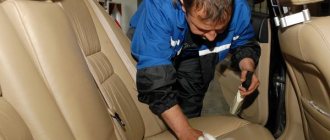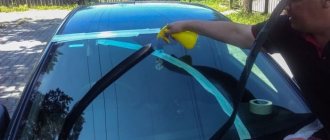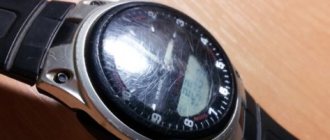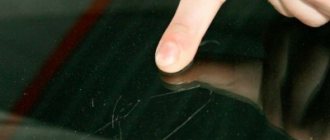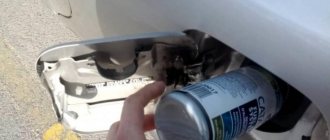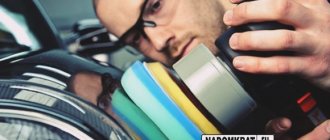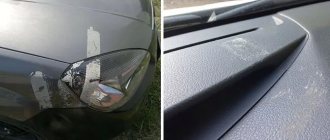Many car owners use tuning for their car as a method of improving its appearance. Some use expensive body kits and unusual decorative elements for this, and some improve the type of transport by gluing various images on them. Often, stickers on a car can arise as a result of the car owner’s desire to make money by sticking advertisements.
Regardless of how the sticker appears on your car, sooner or later there comes a time when it needs to be removed. It turns out that removing a boring pattern from the body or glass of a car is much more difficult than gluing it. In this article, we will look at how to remove the sticker and residual fragments of the adhesive base from the surface of the vehicle, without causing damage to the paintwork and glass surfaces during the process.
Materials required for work
Most modern car stickers, presented in a decent assortment on the market, are made on the basis of high-strength, reliable, moisture-resistant, temperature-resistant vinyl. Emblems and images are primarily intended for one-time use, have an adhesive surface, and have a decent service life, sometimes more than three years. Such super-positive quality characteristics position car stickers from the best side, which, from a different position, causes difficulties when they need to be removed.
Before starting to remove the sticker, the car owner should prepare accordingly: purchase the necessary materials and tools for the work, prepare himself mentally for a responsible, jewelry-making process that requires scrupulousness and diligence. Materials may vary depending on the method of carrying out the procedure, however, there is a clear minimum, which looks like this:
- Warm water and several small clean rags to pre-clean the surface from dirt accumulations and treat the surface under the sticker after its removal. Car shampoo or any other non-aggressive detergent may also come in handy.
- A professional or powerful household hair dryer for heating the adhesive base in order to soften it before removing the picture.
- To directly undermine the edge of the emblem and remove it, you will need a plastic spatula; as an alternative, an old plastic card or other durable, non-metallic, flat object may be useful.
- As a liquid for eliminating residual components of the adhesive base, you can use either special solutions, having previously purchased them at a car store, or gasoline and kerosene available to each car owner. You should be very careful when choosing a liquid so that it is not aggressive to the components of the paintwork.
- If you intend to remove an adhesive object from the body, polishing paste will be needed to smooth out the discrepancy in the color of the body with the area that was under the sticker.
In addition to preparing the materials necessary for direct work, it is important for the performer to focus on his safety. When working with aggressive components, it is important to take precautions, wear thick work clothes, gloves and safety glasses.
Important Tips
We recommend using the tips below. They will help you carry out the film removal process correctly.
- The car frame should not be cold when removing the film. Warm material is easier to remove, it rarely bursts and does not pull the varnish along with it.
- During the removal process, if you find that the film leaves behind adhesive, you should try removing the material from a different angle.
- It would be better to remove the film evenly, slowly.
- There are films that are less easily removed when heated. Or rather, they leave less glue if you remove them cold.
- It is advisable to remove the film by hand, without using any tools. In extreme cases, a special squeegee will not hurt. It is strictly prohibited to remove the film with a knife or other tools.
As you can see, there is nothing particularly complicated in the film removal process. Photos and video materials will only help you understand the rules. We recommend reading other publications and instructions posted on our website.
Forget about fines from cameras! An absolutely legal new product - Traffic Police Camera Jammer, hides your license plates from the cameras that are installed in all cities. More details at the link.
- Absolutely legal (Article 12.2);
- Hides from photo and video recording;
- Suitable for all cars;
- Works through the cigarette lighter connector;
- Does not cause interference to radios and cell phones.
Effective ways to remove stickers
When asked how to remove stickers from a car, there are no clear instructions: the outcome of the process depends on many factors, in particular, the period it was on the car, the quality of the emblem itself and its adhesive, and location.
First, let's look at the options for removing a sticker from a car body. Professionals call the method of heat treatment of the surface as the most effective option for removing patterns from vehicle body parts, which will help soften the adhesive base, with the subsequent possibility of eliminating the sticker.
You can remove the sticker from your car using special household chemicals.
Many household chemical stores or car dealerships, as well as many online stores, sell a large variety of chemical products designed to remove stickers from any surface. Therefore, we advise you to use only special products to remove stickers from your car, as they are designed specifically for this purpose. Remember, friends, that using dubious means in this case using “old-fashioned methods” can cause significant harm to your car.
The German auto magazine Autozeitung selected 12 of the most famous means for removing stickers from a car for a test. Please note that all these products are presented in different price categories. But this cannot mean that the more expensive the product, the more effective it is.
To test THESE products, Avtozhurnal employees, using auto chemicals available on the market, personally removed stickers from the windshield. To make the test fairly fair, stickers were purchased from completely different materials (paper, plastic, film, stickers with a special glue composition). Next, each new sticker was artificially aged to simulate the natural aging of the stickers themselves, and then the windshields with the stickers were placed in a climate chamber for some time. Well, then every chemical agent was tested. Ultimately, experts were able to find out that none of the chemicals presented for testing showed high removal efficiency.
How to eliminate traces or fragments of glue from the body and glass elements of a car
The methodology for removing stickers, if they remain on the car for a long time, even with careful implementation of the process, can result in an unpleasant precedent, in the form of glue residues on the surface that cannot be eliminated. The question of how to remove glue from a sticker from a car is relevant among car owners, since the use of an unsuitable liquid can result in damage to the paintwork, with the need for a complete repainting of the car, or in a chemical effect on the glass, with its subsequent clouding and the need for replacement. None of the options is acceptable for car owners, as it involves significant financial costs.
Which product is the worst for removing stickers from car windows?
During testing, Würth Industry Clean showed unsatisfactory results on some (certain) types of labels. Even after sufficient treatment of the sticker surface itself, a large amount of glue residue remains on the glass.
Common mistakes made by car enthusiasts
An incorrect approach to removing stickers from the body or glass of a car can not only fail to produce results, but also result in serious problems. The most common mistakes when performing work on removing car stickers are the following mistakes with an unfavorable outcome:
- Heating the surface at high power with a hair dryer.
- Using metal-based tools to clean the surface.
- The use of mixtures that react aggressively with paintwork.
- Simultaneous use of chemical treatment methods on the sticker with heat treatment.
Such errors entail permanent damage to the paintwork, which results in the need for repainting or fragmentary painting of the vehicle.
Ignoring safety precautions when working with active chemicals poses a significant danger to the health of the performer. Working without protective equipment can lead to problems with the respiratory organs if special masks are not used, and contact of the performer with aggressive chemicals can cause burns.
Types of films and their features
ATTENTION! A completely simple way to reduce fuel consumption has been found! Don't believe me? An auto mechanic with 15 years of experience also didn’t believe it until he tried it. And now he saves 35,000 rubles a year on gasoline! Read more"
Automotive protective films are designed with the sole purpose of protecting the surface of the vehicle from the effects of aggressive environmental factors. First of all, of course, we are talking about mechanical damage that inevitably occurs during the active operation of the machine.
Naturally, the advantage of such films is the ability to remove and quickly replace them. But without knowing the features of the film, this will be extremely difficult to do.
So, first you need to determine the type of this film itself, which is produced today in 2 main types. As a rule, these are vinyl and polyurethane films that have proven themselves well according to certain criteria.
Vinyl
Thus, vinyl films or VP are considered rather decorative varieties. They are mostly glued completely to the body, thereby changing the color and achieving the aesthetic appeal of the car.
Regarding the color of the VP itself, today the range of models is simply huge. Matte varieties, colored, transparent, and so on are generally accepted. There is also chameleon and metallic, which are ideal for those who just want to refresh the color of the car without changing anything.
Let's sum it up
Stickers and film vinyl coating on cars are actively used by car owners as an improvement in the appearance of the vehicle. The process of pasting, especially small-sized stickers, is one of the most affordable tuning options, which explains the popularity of this method of improving the design of a car.
Problems arise at the stage when the pasted pattern you like becomes boring or other reasons arise that imply the need to remove the emblem. Coping with this task is not always easy, since modern-made car stickers are distinguished by decent strength and durability. This article presents effective methods for dealing with stickers and glue fragments that remain when they are removed, using which any car owner can solve the problem at home.
Delete without a trace
Stickers can be found anywhere - on dishes, clothes, stationery, children's toys, etc. Of course, for those who produce all this, this method of information about the product is very convenient, but when they buy the thing, for obvious reasons they try to rip it off as quickly as possible. However, this is not so easy to do: the sticky mark from the sticker in most cases remains on the surface of the object. How to remove glue from a sticker depends on what material the manufacturers “planted” it on.
When wiping the glue from a sticker from glass, fabric or plastic, you need to try not to damage the base or spoil the appearance of the purchase, as sometimes happens after mechanical removal, so before removing the sticker, you will have to do some preparatory work.
How to remove a sticker from plastic without a trace?
You can try to clean a sticker with a label glued to a plastic surface in this way:
Another answer to the question of how to remove glue from a sticker from plastic is to wipe it off with a soft eraser. After the rubber band has wiped off the adhesive mass, any traces of it are washed off with a soft cloth soaked in soapy water.
What is included in the price of the service
In the salon, to remove the film from the car either completely, by ordering the so-called full sticking, or partially.
For example, a car owner, at his choice, can order the film to be removed from:
- hood;
- rear bumper;
- doors;
- front and/or rear wing, etc.
The pricing policy, with reasonable prices, is based on an individual approach.
The reason is the different condition of the film, its type (polyurethane, vinyl, regular polymer), the material of the car under the coating being removed (paint, glass, plastic), as well as its relief (straight and textured).
Ice
You can erase a label on a plastic coating using frozen water.
How to clean dishes, glass or plastic:
- Apply ice cubes to the glue stain or the label itself.
- Wait 10–15 minutes.
- Try removing the sticker with your hands or use auxiliary tools.
Then use detergent to remove any remaining sticker marks.
